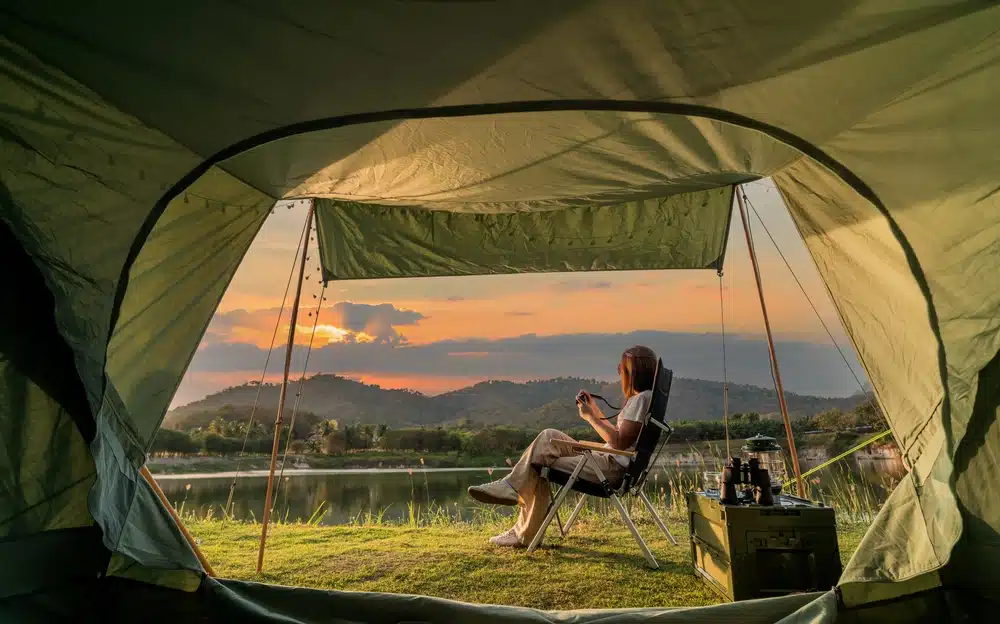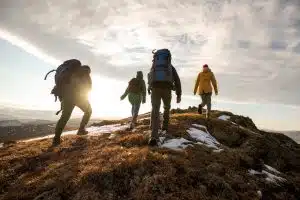Camping Essentials for College Students
Camping is an invaluable experience for college students, offering a much-needed break from the rigors of academia and a chance to escape the confines of technology and urban environments. This immersive outdoor activity encourages personal growth, fosters teamwork, and allows students to create lasting memories with friends. It is important that one prepare the necessary camping essentials.
Engaging in outdoor activities and connecting with nature provides a multitude of physical and mental health benefits, such as reduced stress, improved mood, increased focus, and enhanced creativity. Furthermore, camping promotes a healthy lifestyle by encouraging physical activity, teaching resourcefulness, and nurturing an appreciation for the environment.
To ensure a successful and enjoyable camping experience, it is crucial for college students to be well-prepared with a range of essential camping items, from basic gear like tents and sleeping bags to clothing, cooking supplies, and safety equipment. By familiarizing themselves with the necessary tools and resources, college students can confidently embark on their outdoor adventures and fully reap the numerous benefits that camping has to offer.
Basic camping gear
1. Tent
Selecting the right tent is a crucial aspect of any camping trip, as it serves as your home away from home. When choosing a tent, consider the size and capacity to ensure it comfortably accommodates the number of occupants and their camping gear. It’s generally a good idea to opt for a tent with a capacity slightly larger than the number of users for added comfort.
Durability and weather resistance are equally important, as tents must withstand various weather conditions, such as rain, wind, and even snow. Look for tents made of high-quality materials with sturdy poles, reinforced seams, and a reliable rainfly. Additionally, prioritize ease of setup to save time and energy at the campsite. Many modern tents feature color-coded poles and clips or a freestanding design, simplifying the setup process and allowing you to focus on enjoying your camping experience.
2. Sleeping gear
Comfortable and appropriate sleeping gear is one of the camping essentials for a restful night’s sleep while camping, ensuring you are energized for the day’s activities. Select a sleeping bag rated for the lowest expected temperature of your camping destination, considering the type of insulation (synthetic or down) based on your preferences and budget.
Pair your sleeping bag with a sleeping pad or air mattress to provide insulation from the ground, enhance comfort, and prevent heat loss. Choose between foam pads, self-inflating pads, or inflatable air mattresses, considering factors such as insulation, weight, and packed size. Don’t forget to pack a compact camping pillow or use a stuff sack filled with clothes as a makeshift pillow. Investing in quality sleeping gear will significantly improve your overall camping experience, ensuring you wake up refreshed and ready to explore the great outdoors.
3. Backpack
A suitable backpack is a vital component of any camping trip, as it holds and protects all your essential gear. When choosing a backpack, consider the size and capacity, which should correspond to the duration of your trip and the amount of gear you need to carry.
Backpack capacity is measured in liters, with options ranging from daypacks (15-30 liters) to multi-day packs (50-80 liters) and expedition packs (80+ liters). Prioritize comfort and support by looking for features such as padded shoulder straps, a hip belt, and a ventilated back panel. An adjustable suspension system can also help distribute weight evenly and adapt to different torso lengths.
Opt for a backpack with organizational features like multiple compartments, external attachment points, and zippered pockets to keep your gear organized and easily accessible. A well-chosen backpack not only makes your camping experience more enjoyable but also promotes good posture and reduces the risk of strain or injury.
Clothing for camping and footwear
1. Layering system
The layering system is a critical aspect of dressing appropriately for outdoor activities, as it allows you to adapt to varying weather conditions and maintain a comfortable body temperature. The base layer is the first layer, worn directly against your skin, designed to wick moisture away and keep you dry. Choose moisture-wicking, quick-drying materials such as merino wool or synthetic fabrics, avoiding cotton which retains moisture and can cause chills.
The insulating layer is the second layer, responsible for trapping body heat and providing warmth. Fleece, down, or synthetic insulation jackets are popular options for this layer, offering varying degrees of warmth and weight. The outer layer, or shell layer, serves as a protective barrier against wind, rain, or snow.
Opt for a waterproof, breathable, and wind-resistant material, such as Gore-Tex or eVent, to keep you dry and comfortable in changing weather conditions. By mastering the art of layering, you can stay warm, dry, and comfortable during your camping adventure, regardless of the elements.
2. Weather-appropriate clothing
Weather-appropriate clothing for camping is one of the camping essentials, as it ensures you are prepared for any weather conditions you may encounter. Rain gear, such as waterproof jackets and pants, is crucial for staying dry during unexpected downpours. Look for breathable fabrics to prevent overheating and pack a lightweight rain cover for your backpack to protect your gear.
Sun protection is equally important, as prolonged exposure to the sun can lead to sunburn, dehydration, and heatstroke. Wear lightweight, loose-fitting clothing with a high UPF (Ultraviolet Protection Factor) rating, a wide-brimmed hat, and sunglasses to shield yourself from the sun’s harmful rays. Cold weather clothing is necessary for camping in cooler temperatures, especially at higher elevations or during shoulder seasons.
Opt for insulated jackets, hats, gloves, and warm socks to keep you cozy and comfortable. By packing weather-appropriate clothing, you’ll be well-equipped to face any weather conditions Mother Nature may throw your way during your camping trip.
3. Footwear
Choosing the right footwear is vital for a comfortable and enjoyable camping experience, as it supports and protects your feet during various outdoor activities. Hiking boots or shoes are the primary choice for navigating trails and rough terrain.
Consider factors such as ankle support, waterproofing, and breathability when selecting your hiking footwear, with options ranging from lightweight trail runners to more robust, high-cut boots. Camp shoes or sandals provide a comfortable and breathable option to wear around the campsite, allowing your feet to relax and air out after a long day of hiking.
Opt for lightweight, quick-drying materials that can be easily packed. Socks play a crucial role in foot comfort and blister prevention. Choose moisture-wicking, quick-drying materials like merino wool or synthetic blends to keep your feet dry and comfortable. Pack a few pairs to ensure you always have fresh socks available. With the appropriate footwear and socks, you’ll be well-equipped to tackle any outdoor adventure during your camping trip.
Cooking and food supplies
1. Portable stove or cooking system
A portable stove or cooking system is one of the camping essentials for any camping trip, allowing you to prepare warm meals and beverages in the great outdoors. When selecting a stove, consider the various fuel types available, such as canister stoves that use isobutane-propane blends, liquid fuel stoves that utilize white gas or kerosene, and alternative fuel stoves like alcohol or solid fuel tablets.
Each fuel type has its advantages and drawbacks in terms of weight, burn time, and performance in extreme conditions. Stove efficiency is another important factor, as it impacts fuel consumption and cooking time. Look for stoves with features such as wind protection, simmer control, and integrated heat exchangers for optimal performance.
Lastly, ensure that your chosen stove is compatible with the cookware you plan to use, taking into account factors such as pot size, stability, and the type of cooking you’ll be doing. A reliable and efficient portable stove will greatly enhance your camping experience, providing hot meals and beverages to warm you up and fuel your adventures.
2. Cookware and utensils
Cookware and utensils are part of the camping essentials for preparing and enjoying meals during your camping trip. When selecting pots and pans, opt for lightweight, durable materials such as aluminum, stainless steel, or titanium, which offer varying levels of heat distribution, weight, and durability.
Many camping cookware sets are designed to nest together, saving space in your backpack. For plates, bowls, and cups, choose lightweight, durable options like BPA-free plastic, silicone, or metal to withstand the rigors of outdoor use. Collapsible or nesting designs can help save space and simplify packing. Eating utensils should also be durable and lightweight, with options like sporks or utensil sets made from materials such as aluminum, titanium, or BPA-free plastic.
Some campers may prefer foldable or nesting utensils for added convenience. Investing in a versatile and practical cookware and utensil set will enhance your outdoor culinary experience, allowing you to enjoy satisfying meals while camping.
3. Food storage and preparation
Proper food storage and preparation are crucial for a successful camping trip, ensuring you have a variety of nutritious and satisfying meals to fuel your outdoor adventures. Opt for non-perishable food supplies that are easy to transport and have a long shelf life, such as trail mix, energy bars, dehydrated meals, instant rice or pasta, and canned goods.
These items typically require minimal preparation and can be cooked quickly, conserving fuel and time. Utilize food containers and storage bags, such as reusable silicone bags or plastic containers, to keep your food organized, protected, and fresh. This will also help minimize waste and adhere to Leave No Trace principles. If your trip includes perishable items or requires refrigeration for certain foods, consider bringing a cooler with adequate insulation and ice packs or ice substitutes.
Choose a cooler size that fits your needs and available space, and remember that proper food storage is vital for maintaining food safety and preventing wildlife encounters. By planning and organizing your food storage and preparation, you’ll enjoy delicious and hassle-free meals throughout your camping experience.
Health and safety tips for camping
1. First-aid kit
One good safety tip when you go camping is to prepare a first aid kit. A well-stocked first-aid kit is one of the camping essentials as it allows you to quickly address minor injuries and medical issues that may arise. Basic medical supplies to include in your kit are adhesive bandages, gauze, antiseptic wipes, antibiotic ointment, tweezers, pain relievers, and adhesive tape. Additional items such as moleskin or blister pads, an elastic bandage, and a small pair of scissors can also come in handy.
Don’t forget to pack any personal medications you may require, such as prescription drugs, allergy medication, or an inhaler. Additionally, emergency items like a whistle and signal mirror are useful for attracting attention in case of a more serious situation or if you become lost.
Regularly check and replenish your first-aid kit to ensure you always have the necessary supplies on hand. By keeping a comprehensive first-aid kit readily accessible, you’ll be prepared to handle minor medical issues and emergencies that may occur during your camping trip.
2. Insect repellent and sunscreen
Insect repellent and sunscreen are essential items to pack for any camping trip, as they help protect your skin from harmful insects and sun exposure. Insect repellents, particularly those containing DEET, picaridin, or oil of lemon eucalyptus, can effectively ward off mosquitoes, ticks, and other biting insects, reducing the risk of insect-borne diseases and providing a more comfortable outdoor experience.
Apply the repellent according to the manufacturer’s instructions and reapply as needed to maintain its effectiveness. Sunscreen is crucial for preventing sunburn and reducing the risk of skin damage or skin cancer caused by the sun’s harmful ultraviolet (UV) rays.
Choose a broad-spectrum sunscreen with an SPF of at least 30, and apply it generously to all exposed skin, reapplying every two hours or after swimming or sweating. Combining insect repellent and sunscreen ensures that you stay protected from both insects and the sun, allowing you to fully enjoy your camping adventure without the worry of skin irritation or damage.
3. Navigation tools
Navigation tools are crucial for any camping trip, helping you confidently explore the outdoors and ensuring you stay on course. Traditional map and compass navigation skills remain valuable, allowing you to orient yourself in unfamiliar terrain and find your way even in the absence of electronic devices. Familiarize yourself with map reading and compass techniques before your trip, and always carry a topographic map and a reliable compass as backup navigation tools.
GPS devices or smartphone apps are also useful for navigating in the wilderness, offering convenience and accuracy. Many apps provide offline maps, trail data, and location-tracking features, ensuring you have access to critical information even without cellular service.
Remember to bring a portable charger or spare batteries to keep your electronic devices powered during your trip. By equipping yourself with the appropriate navigation tools and skills, you’ll be able to confidently and safely explore the great outdoors during your camping adventure.
4. Multi-tool or knife
A multi-tool or knife is an indispensable piece of gear for any camping trip, providing a versatile and compact solution for a variety of tasks and situations. Whether you’re preparing food, cutting rope, repairing gear, or performing first-aid, a reliable multi-tool or knife can come in handy. Multi-tools often include features such as a knife blade, scissors, screwdrivers, pliers, and can openers, all of which can be useful in the outdoors.
Choose a multi-tool that offers the functions you’re most likely to need, while keeping in mind the weight and size constraints of your camping gear. Alternatively, a sturdy folding or fixed-blade knife can also be one of the camping essentials for more straightforward cutting tasks.
Whichever option you choose, ensure that it’s made from high-quality materials and is well-maintained to provide optimal performance. Carrying a multi-tool or knife on your camping trip will make tackling various tasks easier and more efficient, allowing you to focus on enjoying your time in nature.
Camp lighting and power
1. Headlamp or flashlight
A headlamp or flashlight is an essential piece of equipment for any camping trip, providing illumination during nighttime activities or in emergency situations. Headlamps offer hands-free convenience, allowing you to perform tasks such as setting up camp, cooking, or navigating trails in the dark. Choose a headlamp with adjustable brightness settings, a comfortable headband, and a long-lasting battery life for optimal performance.
Flashlights, while not hands-free, can also be useful for providing focused light when needed. Opt for a durable, water-resistant flashlight with a powerful beam and a reliable power source. Many campers prefer to carry both a headlamp and a flashlight, ensuring they have versatile camp lighting options for various situations.
Don’t forget to pack extra batteries or a portable charger to keep your lighting devices powered throughout your trip. By including a reliable headlamp or flashlight in your camping gear, you’ll be well-prepared to safely navigate and enjoy the outdoors, even after the sun sets.
2. Lantern for campsite illumination
A lantern is a valuable addition to your camping gear, providing ambient lighting for your campsite and creating a comfortable atmosphere during nighttime activities. Lanterns come in various styles and power sources, such as battery-operated, solar-powered, or fuel-burning options. Choose a lantern that offers adequate brightness for your needs, along with adjustable lighting settings to create the desired ambiance.
Look for features such as durable and water-resistant construction, a stable base or hanging hook, and long-lasting battery life or fuel capacity. Some lanterns also come with additional features like USB charging ports, allowing you to charge electronic devices while providing illumination.
When selecting a lantern for your campsite, consider factors like weight, size, and ease of use, ensuring it suits your camping setup and preferences. A reliable lantern can greatly enhance your camping experience, making your campsite feel more like a home away from home as you enjoy the beauty of the outdoors.
3. Portable charger or solar charger for electronics
A portable charger or solar charger is part of the camping essentials for keeping your electronic devices powered during your camping trip. These chargers ensure that your smartphone, GPS, camera, and other gadgets remain functional, allowing you to stay connected, navigate, and capture memories throughout your adventure. Portable chargers come in various capacities, with higher-capacity models providing more charging cycles for multiple devices.
When selecting a portable charger, consider factors like output voltage, charging speed, weight, and durability. Solar chargers offer a sustainable and eco-friendly alternative, harnessing sunlight to generate power for your devices. These chargers can be especially useful for extended trips or in remote locations where access to a power source is limited.
Opt for a solar charger with efficient solar panels, multiple charging ports, and a compact design for easy packing. By carrying a portable or solar charger, you’ll be well-prepared to keep your essential electronics charged and ready for use, ensuring a seamless and enjoyable camping experience.
Now you understand more about camping essentials, it is important that you consider your college admission. If you are still planning your college admission, you should get guidance from AdmissionSight. With guidance from AdmissionSight’s top experts in college admission with 10 years of experience, you can get into any college you dream of. You can talk to our experts today to get started.










































